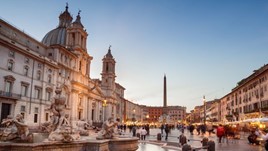
By Parker Ellenburg
Travel Writer and Photographer18 Jun 2018 - 8 Minute Read
Strolling through the bright Italian sunshine on our way to the aerial tram, daypacks on our shoulders, Jason and I talked excitedly about the massifs and towers of stone surrounding us.
It was our first climbing trip since we had both become parents. We’d spent our 20s climbing and skiing together in the Wyoming Tetons with a uniquely 20-something disregard for personal safety. Fixated on getting to the top or making first tracks to the bottom, we would, by design, choose the steepest, most exposed route available.
When planning this trip, we initially planned on scaling the 13,000ft+ (4,000m+) peaks in the Alps. But, looking through eyes re-shaped by the existence of our infant sons, the ropework, crevasses, and sheer volume of accident reports we came across while researching, all glared in a new and not so appealing light.
Suddenly, the name and elevation of the peak, the route, “the top,” all felt meaningless.
We discussed what we wanted from this trip and discovered that, for the first time, maximizing fun meant minimizing risk. So now, here we were, climbing in a new place – the Italian Dolomites – with new priorities.

Due to jet lag, we left our rented apartment in Cortina D’Ampezzo later than we had hoped, but we were in a carefree state of mind as we stopped for take-away coffee at a local café.
Climbing mountains in the Dolomites has not always been a carefree activity. During the First World War, Italy reversed its allegiance to Austria-Hungary, turning their rugged borderlands into battlegrounds and forcing armies to bring war supplies across precarious mountain terrain. To avoid losing soldiers and supplies to the mountain, cables were strung along lofty supply routes. By clipping into these cables, soldiers could move more quickly through exposed terrain without the need for rope or other protective gear.
They transported an arsenal of weaponry over these Via Ferrata (Iron Roads), and even used the mountains themselves as a weapon, deliberately setting off avalanches and sending boulders tumbling down on their enemies.
A hundred years later, the Iron Roads that once served a vicious utility have been reimagined (and expanded) by alpinists as a filigree adorning some of the most classic routes in the Dolomites. We were grateful that there was nothing grim about the way we faced these mountains.
We sipped our coffees while riding the tramcar, the view expanding dramatically as we swept upwards above the tree line. This short ride would save us hours of hiking to the base of the Via Ferrata Punta Anna. We would go the European way: climb the peak, then ride the tramcar down from the summit.

Our climb began with a “clip-clip” as we fastened ourselves to the cable with two carabiners.
Free of our regular climbing kit, we climbed quickly – the wind soon became cool and fresh despite the intense sun. Looking down from our steep, modern route onto the surrounding slopes, we imagined some of the historic paths from the war that was supposed to have ended all wars.
As we climbed into the afternoon, a dim memory flickered, kindling a question we’d neglected to ask: what time was the last tram down the mountain? We stopped at a natural rock arch and pulled out our timetable. Unfolding the glossy pamphlet, running a finger down the departure times… “Ultima Partenza -16:00 (3pm)”.
We would not make it in time.

A frustrated grimace crossed my face as we weighed our options: extend our climb into late, potentially dangerous hours and descend on foot in the dark? Spend the night on the mountain and catch the first tram in the morning? We had headlamps, but neither of us had more than an extra sweater or fleece. We knew from the weather forecast that rain, electrical storms, and freezing rain were likely after the sun went down. We certainly wouldn’t starve, but with little water we would be thirsty.
But then we remembered – nothing was obligating us to reach the top.
Instead of doggedly pursuing the summit, the reflex of our younger climbing selves, we could look for a way to get off the route and try to meet the last tramcar at a mid-mountain station.
We climbed for another hour, then another. Eventually, we came to a ridge with a deep cleft that reached down to a snowfield. It dropped away in the general direction of the mid-mountain station, so we exited the Via Ferrata route, scrambled to the snowfield, and glissaded (a controlled slide) a few hundred feet down to what, in winter, would be a ski run.

Lower on the mountain, the snow melted away, and we ran down the rocky slope. Soon the tram station came into view. As we approached, the cables began to hum above us: the last car was descending from the top of the mountain to meet us.
In a sense, we had failed. But somewhere along the way we must have lost that sense, because we didn’t care at all that we hadn’t reached the top.
We laughed and high-fived, content with our adventure, and relaxed into the anticipation of cold drinks, good food, and the un-conflicted feeling of having honored our need for challenge without compromising what matters most.

Discover similar stories in
transformation
Travel Writer and Photographer
The son of an artist and an inventor, Parker Ellenburg is a Colorado-born adventure seeker and life-long traveler.




No Comments